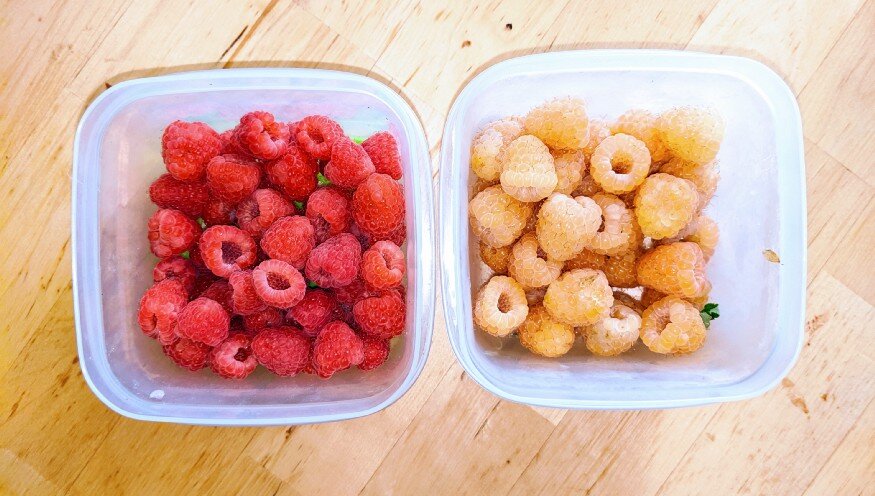Caneberries, Bat-ology, & Druplets!
The term Caneberry refers to a family of flowering plants with woody stems (canes) and small delicate fruits, belonging to the Rosaceae family. To be taxonomically correct— caneberry is simply a quick and common way of saying “a fruit belonging to the Rubus genus”.
Caneberries that you may already be familiar with include: raspberries, blackberries, marionberries, boysenberries, loganberries, tayberries, and perhaps even olallieberries if you’re lucky.
Fun Fact #1:
Batology is not in fact the study of bats; it’s the study of the Rubus genus. So after reading through this article and committing to a little more research, you could in good faith add to your online dating profile, a line mentioning your efforts towards becoming a “Batologist”~ sounds like a winner!
TRUE BERRIES
Fun Fact #2:
In the spirit of keeping things confusing, while all of the fruits mentioned above, literally include the word “berry” in their names…..botanically none of them are actually berries.
Not to freak you out too much, but a strawberry is also not really a berry while a banana IS!!!
What caneberries actually are is AGGREGATE FRUIT.
An aggregate fruit is one that is made up of many clusters of individual sections, called DRUPLETS. How fun! The existence of that really neat word almost makes up for the fact that everything you thought you knew about berries is wrong.
Most caneberry fruits are made up of around 100 drupelets and each one of those druplets contains a seed. In contrast, a true berry is “a fleshy fruit without a stone (pit) produced from a single flower containing one ovary. The seeds are usually embedded in the fleshy interior of the ovary, but there are some non-fleshy exceptions, such as peppers, with air rather than pulp around their seeds.”
The Rubus genus is large and diverse and many varieties come from a complex line of inter-breeding between wild “berries”. Have you ever heard of youngberry, phenomenal berry, or santaimberry? This post from The Fruit Nut Blog: Rubus Diversity and Obscurity…Batology includes an excellent visual aid that quickly shows us how many of the caneberries we commonly eat came to be. Take a quick peek!
RIPENESS
One reason fresh caneberries you find in the grocery store are mediocre at best, is because many varieties are very fragile when fully ripe ~ and in order get the best tasting berries, they should be picked only when fully ripe.
You see, most varieties of caneberries are what is referred to as: non-climacteric fruit.
Non-climacteric fruits produce little or no ethylene gas. This means that while they may soften, after picking, they do not actually ripen any further and there is no benefit to picking an under-ripe fruit hoping it will become tastier on the counter.
In contrast, fruits that ARE climacteric, DO continue to ripen after being picked even while left sitting on your kitchen counter. Examples you are probably familiar with include apples, pears, and plums.
So when searching for the tastiest non-climactic fresh fruits, head out to a farmers market or join a CSA (like this one - shameless plug!) where the “berries” are allowed to hang on the bush as long as possible and only have to travel a few hours or sit for a day in cold storage before they reach your mouth.
PRO TIPS: HARVESTING
Caneberries are highly perishable and maintaining fresh quality after harvest depends on proper handling, transportation, and storage.
Let the fruit fully ripen on the cane.
Harvest early in the day when the temperature is coolest.
Handle the fruit as little as possible - pick straight into the containers they will end up in.
Pre-cool the fruit in cold storage to remove any “field heat” immediately after picking.
Alright, enough with all the learning,
lets get to the delicious part!
RECIPES
Black Raspberry & Rose Geranium Sherbert
Recipe inspired by Deborah Madison, from the book Local Flavors
We highly recommend black raspberries for this recipe if you can get your hands on them, but don’t be afraid to experiment and try different types of canefruits!
Ingredients:
4 cups clean de-stemmed raspberries.
1 cup sugar
Adjust depending on personal preference
2 cups water
4 crushed rose geranium leaves
Rose geranium belongs to the genus Pelargonium and is not technically a geranium. Not all scented geiuniums like rose geranium have a flavor that complimentary to cooking and most will call for either rose, lemon, or mint scented varieties.
1 cup cream
If you need a dairy free option, try a sorbet recipe instead - it will be just as delicious!
A few drops of lemon juice
Tools:
Measuring Cup
Saucepan
Stirring Utensil
Spatula
Food Mill
Alternate Options: Food Processor or Blender & Mesh Strainer with holes small enough to capture raspberry seeds.
Plastic Wrap or Beeswax wrap
Ice Cream Maker
Alternate Option: Metal baking pan or other freezer friendly container.
Directions:
Combine the 2 cups water and 1 cup sugar in a heavy bottomed saucepan and bring to a boil.
Add in the 4 crushed rose geranium leaves and stir.
Add the 4 cups of clean, de-stemmed black raspberries and stir until the sugar is completely dissolved.
Remove the rose geranium leaves.
Let the mixture cool.
Carefully pass the cooled fruit along with the syrup through the food mill.
Alternately, pour the mixture into your food processor or blender, puree, and then pass through your fine mesh strainer to remove the seeds.
Stir In the 1 cup cream
Pause and taste! If you find the mixture too sweet for your liking, add a drop or two of lemon juice to balance out the flavor.
Freezing Option #1: Ice Cream Maker
Before adding the mixture to your machine, cover and chill in the fridge for a couple of hours.
Once it is cold, transfer it to your machine and follow manufacturer instructions.
If it doesn’t harden to the consistency you would like, transfer it to a covered container (we recommend a metal baking pan) and place in the freezer until it reaches the desired consistency.
Freezing Option #2: What if I don’t have an ice cream maker!?
Never fear! You can “still freeze” the sherbet!
Pour the mixture into a metal pan
Cover with plastic or beeswax wrap
Place in the freezer for about four to six hours or until firm (it will have a consistency somewhere between an ice cream and a sorbet).
Make sure to stir the mixture every 45-60 minutes.
Fermented Brambleberry “Shrub”
(aka drinking vinegar)
Recipe inspired by Rosalee De La Foret & Emily Han from the book Wild Remedies
Ingredients:
1 cup (ish) fresh caneberries of your choosing
(aka brambleberries)
1 cup apple cider vinegar
1/2 cup honey or other sweetener of your choosing
Optional: Herbs of your choosing. Blackberries like mint and basil and pair well with oregano, rosemary, sage and thyme. Raspberries match well with thyme, basil, oregano and bay.
Tools:
Sanitized pint jar
Lid for the jar
We suggest using a glass or plastic lid because vinegar can corrode metal. If you only have is a metal lid that’s fine, just place a piece of parchment or waxed type paper between the jar and the lid.
Muddling stick, fork, or masher to smoosh the berries
DIRECTIONS
Lightly pack a clean pint jar with berries.
Fill to cover with vinegar, leaving approx 1/2” of headspace.
Wipe the rim of the jar an attach a lid.
Choose a cool dark place you to store your mixture. Make sure its not so out of the way that you will forget about it!
Check on your mixture and shake daily.
After 1-2 weeks, strain out the berries. You could discard them, but your author prefers to eat them as is, use in other recipes like pancakes, or throw them to the chickens.
Now is the time to taste and add honey if you have sweeter tastes. While you can drink it straight, this “shrub” is typically meant to be added to a carrier liquid like sparkling water or club soda .
Pour the strained mixture into a clean, non-reactive container and store in the fridge.
As long as your container and lid were well sanitized, and your mixture strained, this refrigerated vinegar shrub can be stored for upto a year.
Raspberry Chipotle Freezer Jam
Recipe inspired by The Complete Book of Home Preserving
Short on time or new to canning? Start with Freezer Jam! While the following recipe highlights raspberries, the directions will work just as well for other caneberries.
Ingredients
Yield: approx five 8oz jars
1 pouch of freezer jam pectin
1.5 cups granulated sugar
2-3 chipotle chiles in adobo, finely chopped & nearly pureed
4 cups crushed raspberries
Tools
Medium size bowl
Stirring spoon
Food Processor or Blender
5-6, 8 oz jars with lids, sanitized
Instructions
Combine freezer jam pectin and sugar in a medium bowl and stir until well blended.
Add chipotle chiles plus 2 tsp of the adobo sauce to a food processor or blender and puree.
Fold bold the the chipotle purée and the crushed raspberries into pectin mixture.
Stir for approx 3 minutes.
The mixture is now ready to use fresh, but for longer storage and thickening…..
Transfer the mixture into freezer safe jars, leaving 1/2-inch headspace and apply lids tightly. o room temperature on your counter.
As long as your jars and lids were well sanitized, the jam will stay good in the fridge for up to 3 weeks or you can pop it into the freezer where it should keep for about 1 year.
If you want to experiment with a more savory jam, we also love this version from Pick Your Own that includes, garlic & onion!
BASIC PRESERVATION
Cane and other “berries” can also be canned, frozen, or dried and are excellent as fruit spreads and syrups.
For well detailed instructions for these useful preservation methods, we recommend that you don’t miss reading OSU Extension article, Preserving foods: Berries
WE VALUE YOUR INPUT!
Do you have a great recipe or fun fact you would like to share? Did you read something you think needs to be edited or corrected? Your content contributions help to further the education of the sustainable food growing community at large. Your input is valuable and we would love to share your ideas! Please email any proposed edits and/or additions to: volunteer@homeorchardeducationcenter.org
If you have enjoyed this content and see yourself as a part of the future of resilient community food systems, please consider contributing content or helping out financially if you are in a position to do so. HOEC is a volunteer driven 501(c)3 non-profit. Any amount helps no matter how small ❤️










